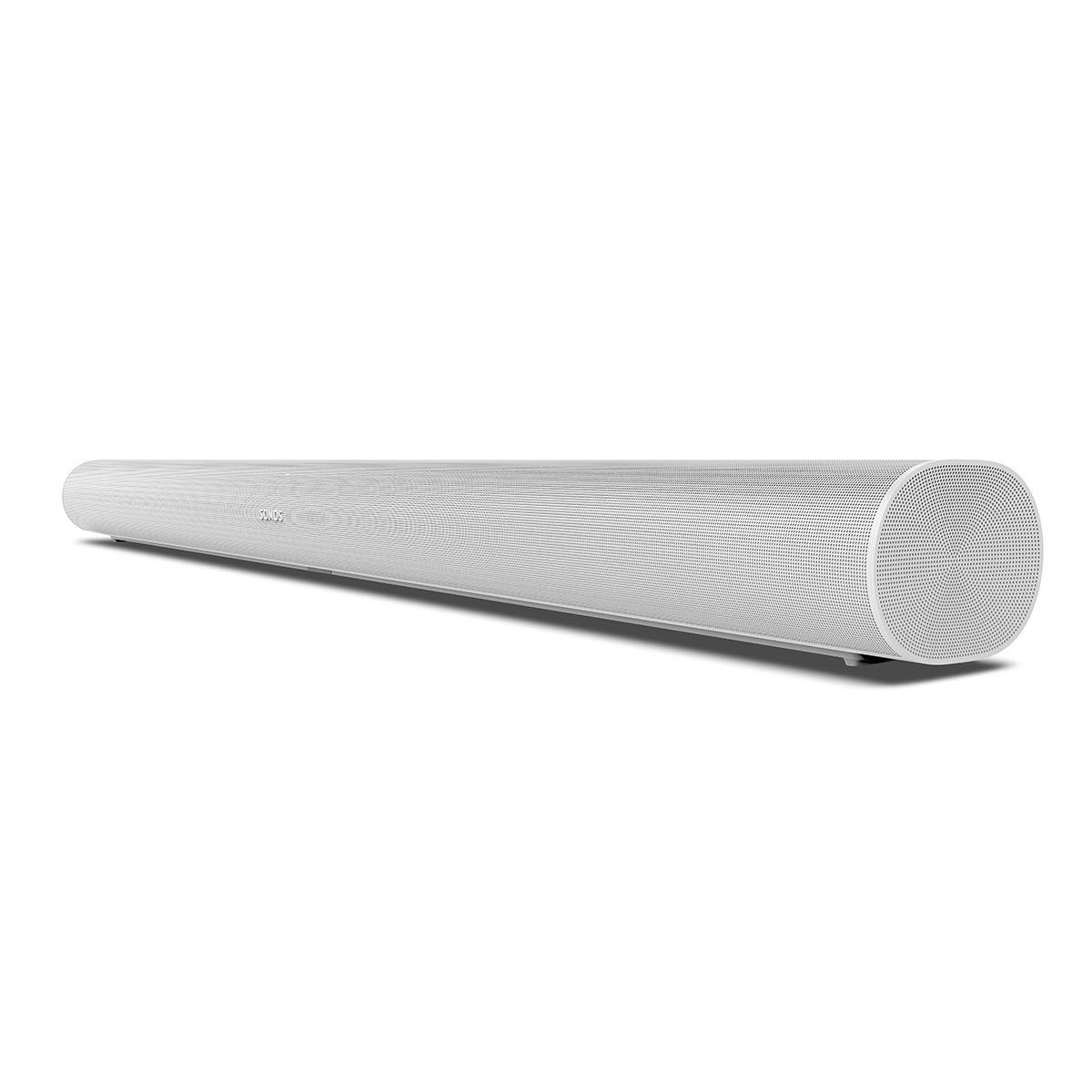
Upgrading your TV's sound can transform your home entertainment experience, and Sonos has long been a leader in premium audio solutions. Let's dive deep into comparing the original Sonos Arc ($564.44) with the newly released Sonos Arc Ultra ($999) to help you make the right choice for your setup.
When the Sonos Arc launched in 2020, it represented a significant leap forward in soundbar technology, bringing Dolby Atmos to Sonos' lineup for the first time. Fast forward to late 2023, and the Arc Ultra arrives with meaningful improvements in driver technology and sound processing capabilities.
The timing of these releases matters - the original Arc was designed when Dolby Atmos was still emerging in home theater, while the Ultra benefits from years of development in spatial audio technology. This progression shows in both the hardware architecture and software processing capabilities.

The original Arc employs 11 drivers in a 5.0.2 channel configuration. This includes three silk-dome tweeters (high-frequency speakers) and eight elliptical woofers (for mid and low frequencies). In contrast, the Ultra packs 14 drivers configured for 9.1.4 channel output, adding dedicated drivers for improved spatial audio and featuring the new Sound Motion woofer technology.
This difference in driver count and configuration has real-world implications. The Ultra creates a noticeably wider soundstage - that's the perceived width and depth of the sound field - and more precise placement of audio elements in space. When watching movies with extensive surround sound mixing, like "Dune" or "Top Gun: Maverick," the Ultra's additional channels create a more convincing three-dimensional sound field.
One of the most significant improvements in the Arc Ultra is its bass response. The new Sound Motion woofer technology delivers approximately twice the bass output of the original Arc. This isn't just about volume - the quality of the bass is also improved, with better definition and control.
While both soundbars can be paired with a Sonos Sub for maximum impact, the Ultra is much more capable as a standalone unit. This could be particularly appealing if you're looking to minimize the number of speakers in your room or if you live in an apartment where too much bass might disturb neighbors.

Both models feature dialogue enhancement technology, but the Ultra takes this further with its Advanced Speech Enhancement system. While the original Arc's speech enhancement was essentially on/off, the Ultra allows you to select different levels of enhancement through the Sonos app. This granular control is particularly helpful during quiet dialogue scenes or when watching content late at night.
The size and shape of your room play a crucial role in how these soundbars perform. Both units use upward-firing drivers to create height effects by bouncing sound off your ceiling, but they need the right environment to work effectively.
The original Arc performs best in rooms with ceiling heights between 7 and 12 feet, while the Ultra seems more adaptable to various room configurations thanks to its improved driver arrangement and processing capabilities.
Room calibration has also evolved. The original Arc relies on Trueplay tuning, which requires an iOS device. The Ultra introduces Quick Tune, which works with both iOS and Android devices, making the setup process more accessible for all users.

Both soundbars support HDMI eARC (enhanced Audio Return Channel) for high-quality audio transmission from your TV. They also include WiFi connectivity and Apple AirPlay 2 support. The Ultra adds Bluetooth capability, which might seem minor but can be convenient for quickly playing audio from guests' devices or when you don't want to use the Sonos app.
Smart home integration remains strong across both models, with support for voice assistants like Amazon Alexa and Google Assistant. The Ultra's improved microphone array makes voice commands more reliable, especially in larger rooms or when there's background noise.
For movie watching, both soundbars excel, but the Ultra pulls ahead in several areas:

While both soundbars handle music well, the Ultra's improved driver configuration and Sound Motion woofer technology provide:
Modern games often feature complex audio mixes, and here the Ultra shows its strengths:
At $564.44, the original Arc represents solid value, especially if found at clearance prices. The Ultra at $999 commands a significant premium but delivers meaningful improvements across the board.
Choose the original Arc if:
Choose the Arc Ultra if:
Both the Sonos Arc and Arc Ultra are excellent soundbars, but they serve slightly different audiences. The original Arc remains a strong performer and value proposition, especially at its current pricing. The Ultra justifies its premium for those seeking the absolute best in sound quality and features, particularly if you're not planning to add a separate subwoofer.
The choice ultimately comes down to your specific needs, room configuration, and budget. Either way, you'll be getting a premium soundbar that will significantly upgrade your home entertainment experience. Remember to consider your long-term plans - if you think you might want to expand your system later, either model will serve as an excellent foundation for a more comprehensive Sonos setup.
| Sonos Arc | Sonos Arc Ultra |
|---|---|
| Price - Consider total value including built-in features | |
| $564.44 (discontinued/clearance pricing) | $999 (current MSRP) |
| Sound Channels - Determines spatial audio quality and immersion | |
| 5.0.2 channels (good for most rooms) | 9.1.4 channels (superior spatial separation) |
| Driver Configuration - Impacts sound quality and precision | |
| 11 drivers (3 tweeters, 8 woofers) | 14 drivers (7 tweeters, 6 midrange, 1 Sound Motion woofer) |
| Bass Performance - Critical for movie impact and music depth | |
| Good bass, but may need separate Sub | 2x bass performance, better standalone use |
| Speech Enhancement - Important for dialogue clarity | |
| Basic on/off enhancement | Advanced with multiple adjustment levels |
| Room Calibration - Optimizes sound for your space | |
| Trueplay (iOS devices only) | Quick Tune (iOS and Android compatible) |
| Connectivity Options - Affects device compatibility | |
| HDMI eARC, WiFi, AirPlay 2 | HDMI eARC, WiFi, AirPlay 2, Bluetooth |
| Voice Assistant Support - Enables smart home integration | |
| Alexa and Google Assistant | Alexa and Google Assistant (improved mic array) |
| Dimensions - Consider TV compatibility | |
| 3.4" x 45" x 4.5" | 3.1" x 46.2" x 4.4" |
| Dolby Atmos Performance - Critical for home theater | |
| Good height effects, standard width | Enhanced height effects, wider soundstage |
| Recommended Room Size - Impacts optimal performance | |
| Small to medium rooms | Medium to large rooms |
The Sonos Arc Ultra ($999) offers superior performance with better bass, more drivers, and improved spatial audio compared to the Sonos Arc ($564.44). However, the original Arc remains an excellent value, especially at its current price point.
The Sonos Arc costs $564.44 (discontinued pricing), while the Sonos Arc Ultra is priced at $999, representing a $435 difference.
The Sonos Arc Ultra provides better movie performance with its 9.1.4 channel configuration compared to the Arc's 5.0.2 channels, offering more precise spatial audio and improved dialogue clarity.
We've done our best to create useful and informative comparisons to help you decide what product to buy. Our research uses advanced automated methods to create this comparison and perfection is not possible - please contact us for corrections or questions. These are the sites we've researched in the creation of this article: whathifi.com - soundandvision.com - en.community.sonos.com - cnet.com - worldwidestereo.com - abt.com - creativeaudio.net - target.com - sonos.com - worldwidestereo.com - businessinsider.com - en.community.sonos.com - youtube.com - bestbuy.com - shopjetson.com - youtube.com - ign.com - crutchfield.com - dowtechnologies.com - appleinsider.com - pcrichard.com - clefdesol.com - sonos.com - businessinsider.com - audioadvice.com - en.community.sonos.com